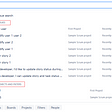Adding a matrix mixer
I hit a snag while building this patch. I wanted to route filtered sound back into my Morphagene. This bit of circular signal flow would let me capture and layer some of the more interesting filter movements, and without devolving into a messy feedback patch.
I started by multing the Belgrad filter’s output to the Morphagene’s right channel, but the Morphagene (as I understand it) uses a dual mono signal flow: left in goes to left out, right in goes to right out, L/R inputs together are not flattened to mono when only L out is connected [1]. This means what’s run into the right channel will only come out of the right output. I want a mono mix, and with some degree of control over levels, so this wasn’t going to cut it.
Because I was ok with a mono mix, I re-patched into a quad VCA (Veils 2) with cascading mixing to its outputs. This, of course, created the hard-to-tame feedback path I wanted to avoid. Using Veils gave me manual level control over signal going back into the Morphagene, which helped tame some feedback, but an overcooked feedback sizzle hovered above everything. Not great.
What would make this routing more natural? A matrix mixer.
What is a matrix mixer?
A matrix mixer is a grid of VCAs that map a series of inputs through a degree of attenuation to a series of outputs. Any input can be routed to any output. The magic of a matrix mixer is that it greatly simplifies complex (or just complicated) signal mixing and routing.
- Rows share input signals across a series of outputs
- Columns offer control over the amount of input signal sent to a certain output
- Each output contains some amount of all inputs, between “none” and “all”
Here’s a simple example of using both of the 258t’s oscillators to FM its top half. (I’m switching to patches from Modular Grid here, because it’s hard to represent the wired matrix mixer in situ in a digraph.)
- The 258t’s top oscillator output is wired to Input 1. The amount of Input 1 present at Output A–the amount of 258t output being sent routed to its FM input–is controlled by the 1-A knob.
- The 258t’s bottom oscillator output is wired to Input 2. As before, the amount of Input 2 sent to Output A, and back to the oscillator’s FM input, is determined by the 2-A knob.
All we’ve done so far is mix two oscillators (Input 1 + Input 2) to Output A.
- Output A, a controllable mix of Inputs 1 and 2, is sent back to the oscillator’s FM input.
- Output B is sent to a mixer for us to listen to. The 1-B knob controls the amount Input 1–the now self-FM’ing 258t’s top oscillator–sent to Output B.
The 258t is now FM’d by a variable mixture of both of its oscillators. Try playing through varying levels. You’ll hear a world of sound.
That’s (mostly) it. There are many types of matrix mixers, and we’re only covering the basics here. Route liberally, mix unexpectedly, and always protect your ears.
Solving my patch problem
Coming back to my patch, here’s a slimmed down look at how I solved my routing problems with a matrix mixer:
The 258t and Morphagene outputs are sent to Inputs 1 and 2. The Belgrad’s output is sent to Input 3. I can mix them together in Column A to Output A, and send it all to Morphagene’s Input L. This is the loop that allows Morphagene to have the out-of-body experience I’m looking for, where it hears itself in “true” form, and filtered.
Output B’s 2-B knob is the volume knob that carries the Morphagene’s signal into the Belgrad. Output C carries the balance of it all forward into the Verbos Multi-Delay, which–use your imagination here–is monitored.
I’ve built a network of interactivity capable of sharing sound to many destinations, linear and recursive, and maintained playability and control. Problem solved, and then some.
I’ll recommend the Doepfer A-138m because I think it looks smart, each channel can be unipolar or bipolar, and the knobs feel great. There is no shortage of other options.





